eugene merle
shoemaker
gene shoemaker
los angeles 28 aprile 1928 - alice spring australia 18 luglio
1997
welcome shoemaker
A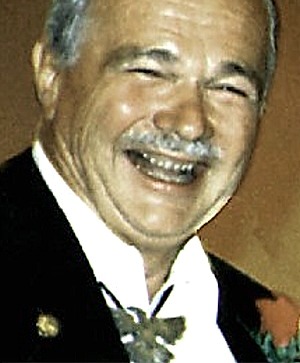 pril 28, 1928 - July 18, 1997 pril 28, 1928 - July 18, 1997
He once said he considered himself a scientific historian, one whose mission
in life is to relate geologic and planetary events in a perspective manner. A
modest statement coming from a legend of a man who almost single-handedly
created planetary science as a discipline distinct from astronomy. He brought
together geologic principles to the mapping of planets, resulting in more than 3
decades of discoveries about the planets and asteroids of the Solar System. He
was a 1992 recipient of the National Medal of Science, the highest scientific
honor bestowed by the President of the United States, then George Bush. His
family, friends, former students, and the scientific community are in shock as
they hear the news and feel the loss of "SuperGene."
Dr. Gene Shoemaker died Friday, July 18 (Australian Time) in Alice Springs,
Australia in a car accident. He was in the field, pursuing his lifelong passion
of geologic studies to help understand impact craters with his wife and science
partner, Carolyn Shoemaker. Carolyn survived the accident sustaining various
injuries.
.
Parte delle sue ceneri furono disperse sul polo sud lunare dalla sonda
della NASA Lunar Prospector nel 1997, l'anno seguente alla sua morte,
avvenuta in Australia a causa di un incidente stradale .
scienze.fanpage.it . 2020
Le sue ceneri sono state
parzialmente lanciate dentro una capsula proprio sulla Luna dove si
trovano tutt’ora .
ecoo.it/articolo/e-stato-sepolto-sulla-luna
- 2023
.
A longtime resident of Flagstaff, Arizona, in 1961 Gene
invented the Branch of Astrogeology within the U.S. Geological Survey and
established the Field Center in Flagstaff in 1963. Retired from the USGS in
1993, he has held an Emeritus
position there and has been recently affiliated with Lowell Observatory in
Flagstaff. An incredibly diverse person, he influenced science in numerous ways:
most recently, in a decade-long sky survey for earth-crossing asteroids and
comets, culminating in the discovery (with wife Carolyn and David Levy) of Comet
Shoemaker-Levy, which impacted Jupiter in 1994, giving the world of science a
major new insight into both the dynamics of comets and the planetary science of
Jupiter. He has spent numerous summers (Australian winters) exploring ancient
parts of the earth for records of meteorite and comet impacts, resulting in the
discovery of a number of new craters. In much of his asteroid and comet work,
Shoemaker collaborated closely with his wife, Carolyn, a planetary astronomer. A
close and devoted couple, their work was recently featured in a 1997 National
Geographic documentary "Asteroids: Deadly Impact." They considered their work a
"Mom and Pop" op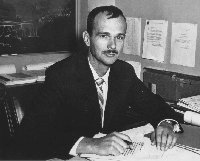 eration and together they initiated the Palomar
Planet-crossing Asteroid Survey in 1973, and the Palomar Asteroid and Comet
Survey in 1983. eration and together they initiated the Palomar
Planet-crossing Asteroid Survey in 1973, and the Palomar Asteroid and Comet
Survey in 1983.
Gene Shoemaker seems to have been a geologist from the day he was born in Los
Angeles, California, in 1928. He did not even need to complete his higher
education (B.S. and M.S., California Institute of Technology, 1947 and 1948;
Ph.D. Princeton University after an interrupted career, 1960) before starting
the practice of astrogeology that was to lead him to the planets. He began
exploring for uranium deposits in Colorado and Utah in 1948, and these studies
brought him geographically and intellectually near the many volcanic features
and the one impact structure on the Colorado Plateau in the western United
States, namely Hopi Buttes and Meteor Crater. In the period 1957-1960, he did
his classic research on the structure and mechanics of meteorite impact. This
work--including the discovery of coesite (a high pressure form of silica created
during impacts) with E.C.T. Chao--provided the definitive work on basic impact
cratering. It was work that he continued throughout his life--both by
exploration of the earth--particularly in Australia--and the planets by remote
sensing and mapping.
A man of vision, he believed geologic studies would be extended into space
and in his early career he dreamed of being the first geologist to map the Moon.
During the 1960's he lead teams who were investigating the structure and history
of the Moon and developing methods of planetary geologic mapping from telescope
images of the Moon. A health problem prevented his being the first astronaut
geologist, but he personally helped train the Apollo Astronauts and sat beside
Walter Cronkite in the evening news giving geologic commentary during the Moon
walks. He was involved in the Lunar Ranger and Surveyor programs, continued with
the manned Apollo programs, and culminated his moon studies in 1994 with new
data on the Moon from Project Clementine, for which he was the science-team
leader.
Gene was the recipient of numerous awards including: Doctorate of Science
Arizona State College, Flagstaff, 1965. Wetherill Medal of the Franklin
Institute, co-recipient with E.C.T. Chao, 1965. Arthur S. Flemming Award, 1966.
Doctorate of Science, Temple University, 1967. NASA Medal for Scientific
Achievement, 1967. U.S. Department of the Interior Honor Award for Meritorious
Service, 1973. Member, U.S. National Academy of Sciences, 1980. U.S. Department
of the Interior Distinguished Service Award, 1980. Arthur L. Day Medal of the
Geological Society of America, 1982. G.K. Gilbert Award of the Geological
Society of America, 1983. Reiser Kulturpreis, co-recipient with E.C.T. Chao and
Richard Dehm, 1983. Honorary Doctorate of Science, University of Arizona, 1984.
Barringer Award of the Meteoritical Society, 1984. Kuiper Prize of the American
Astronomical Society, Division for Planetary Sciences, 1984. Leonard Medal of
the Meteoritical Society, 1985. Distinguished Alumni Award of the California
Institute of Technology, 1986. Rittenhouse Medal of the Rittenhouse Astronomical
Society, co-recipient with C.S. Shoemaker, 1988. U.S. National Medal of Science,
1992. Whipple Award, American Geophysical Union, 1993. Fellow, American Academy
of Arts and Sciences, 1993. AIAA Space Science Award, 1996. NASA Exceptional
Scientific Achievement Medal, 1996. Bowie Medal, American Geophysical Union,
1996. Special Award, American Association of Petroleum Geologists, 1997.
Shoemaker Award, Texas Section of the American Institute of Professional
Geologists, awarded posthumously, 1997.
...
On Valentines Day, 2000 the thruster burn to put the Near
Earth Asteroid Rendezvous (NEAR)
Spacecraft into orbit around Asteroid Eros went as close to perfect. The NASA
satellite is conducting the first-ever close-up study of an asteroid. The images
of Eros sent back to Earth by the spacecraft show a surface covered with craters.
During the Lunar and Planetary Science Conference in Houston (3/14/00), Carl B.
Pilcher, Director of Solar System Exploration at NASA Headquarters, announced
that the spacecraft, currently orbiting asteroid 433 Eros more than 145 million
miles from Earth, will now be known as NEAR Shoemaker, to posthumously honor
Eugene M. Shoemaker and his ground breaking work with NASA, the Moon, other
planets, and asteroids. Carolyn Shoemaker accepted in Gene’s behalf.
...
Shoemaker Ballad by Bevan M. French (NASA)
On the occasion of Gene Shoemaker's retirement from the USGS Bevan French
composed a ballad in his honor. Bevan French has been a member of the Impact
community of scientists and knew Gene for 30 years. Bevan retired from NASA
Headquarters in 1994 and is now a Visiting Scientist with the Smithsonian
Institution (202-357-1852, mnhms053@sivm.si.edu). If you have the
RealAudio player you can listen to Bevan's
introductory comments and hear him sing the
ballad. We also have the written lyrics.
...
see all at
http://astrogeology.usgs.gov
NEAR shoemaker

NASA has renamed the Near Earth Asteroid Rendezvous (NEAR) spacecraft for
planetary science pioneer Gene Shoemaker.
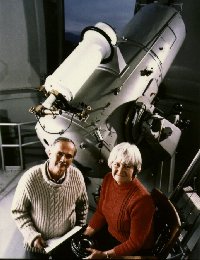 March 14, 2000 -- The NASA satellite conducting the first-ever close-up
study of an asteroid will be renamed to honor Dr. Eugene M. Shoemaker, a
legendary geologist who influenced decades of research on the role of asteroids
and comets in shaping the planets. The Near Earth Asteroid Rendezvous (NEAR)
spacecraft, currently orbiting asteroid 433 Eros more than 145 million miles
from Earth, will now be known as NEAR Shoemaker. March 14, 2000 -- The NASA satellite conducting the first-ever close-up
study of an asteroid will be renamed to honor Dr. Eugene M. Shoemaker, a
legendary geologist who influenced decades of research on the role of asteroids
and comets in shaping the planets. The Near Earth Asteroid Rendezvous (NEAR)
spacecraft, currently orbiting asteroid 433 Eros more than 145 million miles
from Earth, will now be known as NEAR Shoemaker.
"Gene Shoemaker was an inspirational, charismatic pioneer in the field of
interplanetary science said Dr. Carl B. Pilcher, Director of Solar System
Exploration at NASA Headquarters, Washington, DC. Pilcher announced the new name
today during the Lunar and Planetary Science Conference in Houston. "It is a
fitting tribute that we place his name on the spacecraft whose mission will
expand on all he taught us about asteroids, comets and the origins of our solar
system."
Above: Gene Shoemaker with his wife Carolyn. A
close and devoted couple, their work was featured in a 1997 National Geographic
documentary "Asteroids: Deadly Impact." They
considered their work a "Mom and Pop" operation and together they initiated the
Palomar Planet-crossing Asteroid Survey in 1973, and the Palomar Asteroid and
Comet Survey in 1983.
Shoemaker died in a 1997 car accident in the Australian outback while on an
annual study of asteroid impact craters. With his wife and research partner,
Carolyn, Shoemaker was part of the leading comet discovery team of the past
century, perhaps most famous for finding the comet (Shoemaker-Levy 9) that broke
up and collided with Jupiter in 1994.
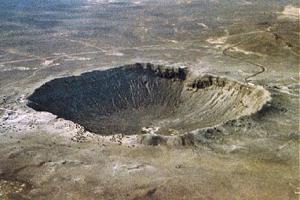 He was an expert on craters and the impacts that caused them. Shoemaker's work
on the nature and origin of Meteor Crater in Arizona in the 1960s laid the
foundation for research on craters throughout the solar system. He also
established the lunar geological time scale that allowed researchers to date the
features on the moon's surface.
He was an expert on craters and the impacts that caused them. Shoemaker's work
on the nature and origin of Meteor Crater in Arizona in the 1960s laid the
foundation for research on craters throughout the solar system. He also
established the lunar geological time scale that allowed researchers to date the
features on the moon's surface.
Left:
49,000 years ago a large space rock hit Earth and created the Barringer Meteor
Crater in Arizona. Gene Shoemaker's seminal work on the famous Arizona crater
helped astronomers understand craters throughout the solar system. Image credit:
D. Roddy (LPI)
Though he never realized his dream of tapping a rock hammer on the moon,
Shoemaker taught Apollo astronauts about craters and lunar geology before they
left Earth. Last year, when NASA's Lunar Prospector spacecraft crashed on the
Moon in an experiment at the end of its mission, a small vial of Shoemaker's
ashes, carried aboard the spacecraft, was scattered on the lunar surface.
Shoemaker was a key member of the 1985 working group that first studied the NEAR
mission, defining its science objectives and designing a conceptual payload.
Many of the group's recommended instruments were included in the actual
spacecraft, which only a month into its year-long orbit of Eros is already
returning fascinating data on the asteroid's surface and geology.
="Hubble images of Shoemaker-Levy 9" src=
Above:
Comet Shoemaker-Levy 9, named after its co-discoverers, was often referred to as
the "string of pearls" comet. It is famous for its suggestive appearance as well
as its collision with the planet Jupiter! The comet's original single nucleus
was torn to pieces by Jupiter's strong gravity during a close encounter with the
solar system's largest planet in 1992. The pieces are seen in this composite of
Hubble Space Telescope images to be "pearls" strung out along the comet's
orbital path.
The first in NASA's Discovery Program of low-cost planetary missions, NEAR
launched from Cape Canaveral Air Station, FL, on Feb. 17, 1996. After a
four-year journey that included flybys of Earth (Jan. 1998) and asteroids
Mathilde (June 1997) and Eros (Dec. 1998), NEAR began orbiting Eros on Feb. 14,
2000. The car- sized spacecraft will observe the asteroid from various distances
-- coming within several miles of the surface -- before the mission ends in
February 2001. The Johns Hopkins University Applied Physics Laboratory in Laurel,
MD, designed and built the NEAR spacecraft and manages the mission for NASA's
Office of Space Science.
science.nasa.gov
EUGENE M. SHOEMAKER
It was legend among planetary scientists that Eugene M. Shoemaker, a pioneer
in the exploration of the Solar System, had longed to go to the Moon as an
Apollo astronaut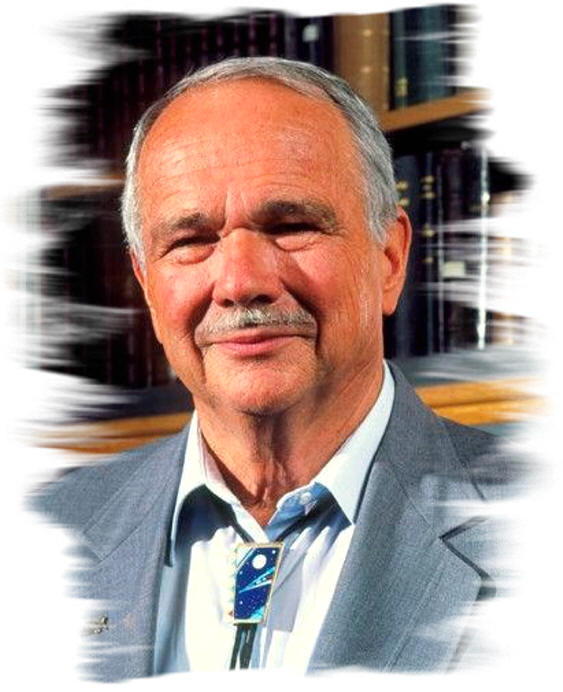 and study its geology firsthand. Unfortunately, a medical
condition diagnosed in the early 1960s prevented him from doing so. and study its geology firsthand. Unfortunately, a medical
condition diagnosed in the early 1960s prevented him from doing so.
Instead, he helped select and train the Apollo astronauts in lunar geology
and impact cratering, and devoted his life's work to investigating the geology
of Solar System bodies, studying the effects of cosmic impacts, and searching
for comets with his wife, Carolyn. His seminal achievements in these areas
earned him the United States' highest scientific honor, the National Medal of
Science, in 1992. He became world-renowned when he, his wife, and astronomer
David Levy discovered Comet Shoemaker-Levy 9, an icy body torn apart by
planetary tides before its fiery impact into the planet Jupiter in July 1994.
Throughout a rich and rewarding life as scientist, teacher, and explorer, his
unfulfilled dream continued to haunt him. Only two years before he died, he
said, "Not going to the Moon and banging on it with my own hammer has been the
biggest disappointment in life".
Shoemaker was finally, in death, granted his wish. On Janury 6, 1998, a small
polycarbonate capsule carrying an ounce of his cremains traveled to the moon
aboard NASA's Lunar Prospector spacecraft. Wrapped around the capsule was a 1.5
inch (3.8 cm) square piece of brass foil, laser-inscribed with a composite image
(shown above) designed to commemorate Shoemaker's scientific legacy.
The top of the inscription features an image of Hale-Bopp, the comet that
graced the spring skies of Earth in the year that Shoemaker died, and the last
comet that the Shoemakers observed together. This image, taken on April 14, 1997
from Tucson, AZ, dramatically displays the details in both the comet's ion and
diffuse dust tails. In the lower left corner is Shoemaker's favorite photo of
Meteor Crater, the 4000 ft (1.2 km) wide and 750 ft (230 m) deep bowl-shaped
depression in northern Arizona where he trained the Apollo astronauts. In 1960,
it was Shoemaker who provided convincing evidence that the crater was formed by
an impact event. Later, he and his colleagues demonstrated that the impact
occurred about 50,000 years ago, shortly before humans permanently inhabited
this part of the Colorado plateau.
And at the inscription's center is a passage from William Shakespeare's
enduring love story, "Romeo and Juliet", chosen for its apt expression of the
warmth and admiration bestowed on Shoemaker by his friends, colleagues and
fellow explorers all over the world.
On July 31, 1999, after eighteen months of successful orbital scientific
operations, Lunar Prospector was commanded to crash into the surface of the
Moon. The fulfillment of one man's dream, and the final episode of his
inspirational life, met on impact.
At his journey's end, thirty years to the month after humans first set
foot on the Moon, Eugene M. Shoemaker became the first inhabitant of Earth
to be sent to rest on another celestial body.
lpl.arizona.edu/~carolyn/tribute.html
comet shoemaker-levy collision with
jupiter
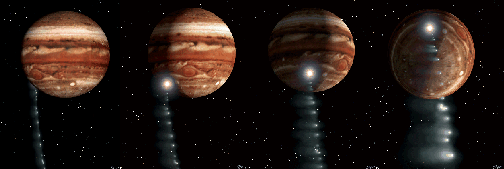
From July 16 through July 22, 1994, pieces of an object designated as Comet
P/Shoemaker-Levy 9 collided with Jupiter. This is the first collision of two
solar system bodies ever to be observed, and the effects of the comet impacts on
Jupiter's atmosphere have been simply spectacular and beyond expectations. Comet
Shoemaker-Levy 9 consisted of at least 21 discernable fragments with diameters
estimated at up to 2 kilometers.
www2.jpl.nasa.gov
EUGENE M. SHOEMAKER
written by brian marsden
Gene Shoemaker, renowned both as a geologist and an astronomer, and a member
of the Board of Directors of The Spaceguard Foundation, was killed instantly on
the afternoon of July 18, when his car collided head-on with another vehicle on
an unpaved road in the Tanami Desert northwest of Alice Springs, in the Northern
Territory of Australia. His wife Carolyn, who had closely collaborated with him
in both his geological and his astronomical activities for many years, was
injured in the accident and is in stable condition in Alice Springs Hospital.
Born in Los Angeles, California, on 1928 April 28, Eugene Merle Shoemaker
graduated from the California Institute of Technology in Pasadena at the age of
19. A thesis on the petrology of Precambrian metamorphic rocks earned him a
master's degree only a year later, at which point he joined the United States
Geological Survey, an organization with which he remained at least partly
associated for the rest of his life. His first work for the USGS involved
searching for uranium deposits in Colorado and Utah. While doing this, he also
became interested in the moon, the possibility of traveling there, and of
establishing the relative roles of asteroidal impacts and volcanic eruptions in
forming the lunar craters. He then embarked on work for a Ph.D. at Princeton
University, intending to continue his study of metamorphic petrology, although
this was interrupted when the USGS again sent him to the field, this time
leading him to an investigation of volcanic processes, for it was in the eroded
vents of ancient volcanoes that the uranium deposits were often located.
Gene Shoemaker and Carolyn Spellman were married in 1951. A visit to
Arizona's Meteor Crater the following year began to set Gene toward the view
that both it and the lunar craters were due to asteroidal impacts. In 1956 he
tried to interest the USGS in the construction of a geological map of the moon.
This work was sidelined, because the national interest in the production of
plutonium led him to study of the craters formed in small nuclear explosions
under the Yucca Flats in Nevada and invited a comparison with Meteor Crater. It
was then that he did his seminal research on the mechanics of meteorite impacts
that included the discovery, with Edward Chao, of coesite, a type of silica
produced in a violent impact. Awarded a master's degree in 1954, Gene Shoemaker
received his doctorate from Princeton in 1960 with a thesis on Meteor Crater.
In 1961 he took a leading role in the USGS venture, in Flagstaff, Arizona,
into the study of "astrogeology", the Ranger missions to the moon and the
training of the astronauts. It had long been Gene's dream to go to the moon
himself, but in 1963 he was diagnosed as having Addison's disease, a condition
that prevented him from becoming an astronaut. When the USGS Center of
Astrogeology was founded in Flagstaff in 1965, he was appointed its chief
scientist and organized the geological activities planned for the lunar
landings. In 1969 he returned to Caltech as a professor of geology and served
for three years as chairman of the Division of Geological and Planetary Sciences
there. Until he retired from the professorship in 1985 he divided his time
between Pasadena and Flagstaff. He continued to maintain an office in the USGS
Astrogeology building after his formal retirement in 1993, while at the same
time taking up a position at the Lowell Observatory.
It was shortly after the 1969 arrival in Pasadena that he became interested
in extending his geological knowledge of the formation and distribution of
terrestrial and lunar impact craters to the study of the astronomical objects
that formed them. With Eleanor Helin he developed a plan to search for such
objects--the Apollo asteroids--with the 0.46-m Schmidt telescope at Palomar.
This search program had its first success in July 1973 and was soon, with the
help also of a number of students and of collaborations using other Schmidt
telescopes, significantly augmenting the rather meager knowledge that had been
accrued on these objects during the previous four decades.
Carolyn became involved with measuring images from the Palomar films in 1980,
and in 1982 the Helin and the Shoemaker observing programs with the 0.46-m
Schmidt went their separate ways. Carolyn proved to be very adept at scanning
the Schmidt films, and this new phase of the search program had its first
success with the discovery of (3199) Nefertiti, an Amor asteroid with its
perihelion 0.13 astronomical unit outside the earth's orbit. In 1983 the first
of the record 32 comets associated with the Shoemaker name was discovered. By
the time the observing program ended, in late 1994, it had produced 40 of
the--now--417 known Amor, Apollo and Aten asteroids (the orbits of this last
group being smaller than that of the earth). Together with the other observing
programs at Palomar, the Shoemakers have ensured that Palomar recently became
and is likely to remain the leading site for the discovery of asteroids, with
currently more than 13 percent of asteroids that have been numbered having been
found there. A few months before the Shoemaker program was terminated came its
"defining moment", with Gene receiving the thrill of his lifetime when some 20
components of one of those 32 comets were observed to crash into the planet
Jupiter with astoundingly dramatic results.
Carolyn also went along on Gene's annual trips to Australia to examine impact
craters, and the tragic irony that his own death should occur there as the
instantaneous result of another violent impact would not have been lost on him.
Gene lived as he died, active to the hilt, his enquiring mind participating in
the adventure of ever learning more over an unusually large range of scientific
disciplines. His many honors included the Wetherill Medal of the Franklin
Institute in 1965, election to membership in the National Academy of Sciences in
1980, the Gilbert Award of the Geological Society of America in 1983 and the
Kuiper Prize of the American Astronomical Society in 1984. Above all, he was
truly the "father" of the science of near-earth objects, to the discovery and
study of which The Spaceguard Foundation is dedicated, and his expertise and
drive will be sorely missed.
www2.jpl.nasa.gov
![[ image: width=150]](grafica/SHOE009.jpg)
The "burial"
of one ounce of Eugene Shoemaker's ashes is a rare honour accorded to a member of the space community.
Mr
Shoemaker co-discovered the comet Shoemaker-Levy 9, which collided with the
planet Jupiter in 1994.
The
renowned astro-geologist, was killed in a car crash two years ago.
"He is
the very first human inhabitant of Earth to be laid to rest on another celestial
body said Carolyn Porco, a University of Arizona professor and Shoemaker's
college on Nasa's Voyager expeditions.
"That's very significant because it says we have arrived
at our place in the solar system, the solar system is our own and it's beckoning
us." ...
news.bbc.co.uk - 1999
.
.
We expect that the study of lunar geology will help
to answer some longstanding questions about the early evolution of the earth .
The moon and the earth are essentially a two-planet system, and the two bodies
are probably closely related in origin . In this connection
the moon is of special interest because its surface has not been subjected to
the erosion by running water that has helped to shape the earth's surface .
- ems
scientific american - todayinsci.com
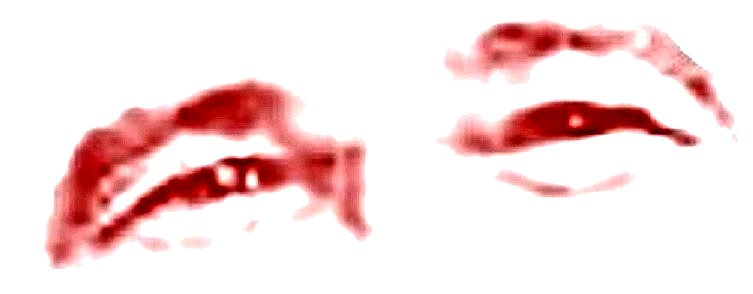
links
https://it.wikipedia.org/wiki/Eugene_Shoemaker
www.vanillamagazine.it/unico-essere-umano-sepolto-sulla-luna
www.castfvg.it/comete/shoemaker/shoemaker.htm
altri autori
 home home
|